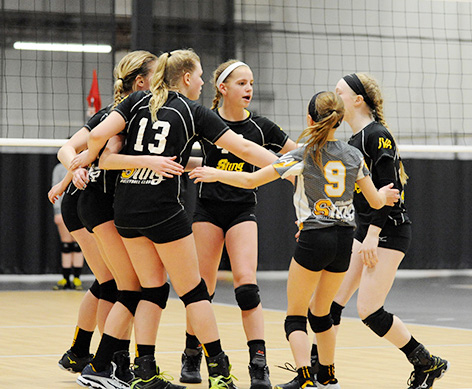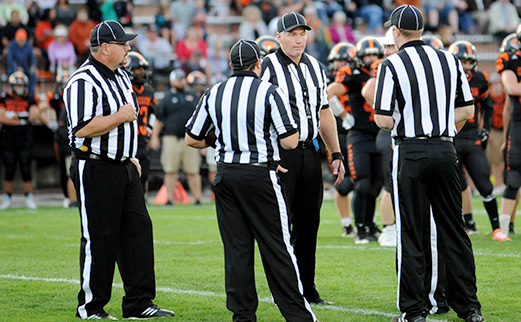The plateauing program
Understanding why some programs hit a wall and how they can break through it

A plateauing program is one that attains a certain level of success but can’t seem to move beyond it.
These are the teams that win roughly half of their games each year and do just enough to keep their administrators somewhat content.These also are the perennial NCAA bubble teams that are always hoping to make the tournament but somehow end up on the outside looking in. Or maybe they make the tournament but can’t make it very far.
Plateauing programs just never seem to get over the hump. Programs can level off at various points for a variety of subtle and not so subtle reasons. In the end, plateauing programs usually end up defeating themselves from within because of limiting mindsets and practices that have taken hold within the program.
Let’s take a look at eight limiting factors that can put a powerful lid on a plateauing program and limit its potential.
1. The talent lid.
Obviously, one significant limit that many plateauing programs face is a lack of elite talent. To compete with the big dogs and break into the next level, you must be rich with talent. You can’t expect C- and B-level athletes to consistently win against A players.
The University of North Carolina men’s basketball coach Roy Williams says, “Recruiting means everything. I know that I am only as good as the players I can put on the court. In the summer of 2000, I went to visit legendary UCLA coach John Wooden and he said something that has always stuck with me: ‘Roy, you can coach talent. Some guys can’t. Nobody can coach no talent, but you can coach talent.’ That has driven me ever since to make sure that I have talent to coach.”
Top talent gives you an opportunity to compete with the best, but it doesn’t always guarantee championships. Ask yourself whether you have the talent necessary to win at the elite level.
2. The expectations lid.
While insufficient talent can be a significant barrier for many teams, another symptom of plateauing programs is insufficient expectations.
I was speaking recently with a coach of a perennial NCAA tournament team and she said one of her leaders asked the team, “How mad and upset would you be if we didn’t make the tournament?” The teammates told her they would be extremely upset, absolutely beside themselves, and that would not be acceptable for the program.
She then asked the team, “How upset would you be if we didn’t make it to the championship round?” The team responded with, “We would be sad but it wouldn’t be as big of a deal.” It then dawned on them that the reason they probably hadn’t progressed to the championship round over the last few years was that it wasn’t as much of a genuine expectation for them.
You and your team’s expectation level can put a powerful lid on your program’s potential, causing it to hit a wall. Where you set your expectations as a coaching staff and team has a big impact on your success.
3. The confidence lid.
Some teams plateau because of a lack of confidence. They may perform well against teams they are supposed to beat and even ones that are perceived to be at their level. But when it comes to playing higher ranked teams, they don’t believe they can match up and perform below their potential. They just don’t see themselves there. Confidence is such a huge part of sports, so your team will absolutely need it to breakthrough to the elite level.
4. The commitment lid.

In addition to insufficient talent, expectations and confidence, another reason why many teams get stuck in the plateauing stage is that they don’t have the commitment necessary to win at a higher level.
To reference my Commitment Continuum, you are not going to win consistently if you have a team of compliant athletes versus one with committed and compelled athletes. A compliant team might work hard during the season or when a coach is watching, but offseason training is basically nonexistent, working out in the weight room is seen as a sacrifice and not an investment, few come to open gym, the athletes are in decent but not dominating shape and not many come early or stay late after practice for extra work. The team basically gets what it invests: nothing much.
You must ask whether your athletes have invested the quantity and quality of work necessary to be a top tier program.
5. The competitiveness lid.
How badly does your team want to win? Sometimes a team doesn’t advance to an elite level simply because it just doesn’t mean as much to them as it does to their opponents. They don’t prepare or compete with a high level of intelligence and intensity necessary to win at the elite level. As an example, in our “Develop Relentless Competitors Drillbook,” I share the following story from the book, “High Hopes:”
“There was a high school team that practiced near a small lake. Across the lake lived coach Jones, the winningest coach in the history of the state, and he was retired. Every day this high school team would come out and practice and practice hard, as hard as they could practice. But no matter how hard they practiced, they couldn’t win. Every day, the retired coach would sit in his lawn chair and watch them.
One day the quarterback decided he was going to go talk to Jones and ask him what he sees. So the quarterback went around the lake and said, ‘Coach, I know you watch us practice every day. I know you know how hard we practice. I know you know how to win. Is there anything you can tell us that will help us win?’
Jones put his arm around the player and walked him near the lake. Suddenly, he grabbed the quarterback, thrust his head into the water, and held him down under the water.
So the kid is about to drown, and coach Jones pulls him up and says, “When you want to win as much as you wanted that next breath, then that’s when you’ll win.”
Consider how much your team wants it and whether you and your athletes are willing to compete that hard.
6. The comfort zone lid.
Einstein is often credited with the quote, “Insanity is doing the same thing over and over and expecting different results.” Similarly, Tony Robbins has said, “If you do what you’ve always done, you’ll get what you’ve always gotten.”
Some programs plateau because they don’t look to innovate and get locked into a comfort zone of making the same program-limiting mistakes over and over gain. They are unwilling to take a hard and honest look at themselves and what they are doing to contribute to the plateauing.
Others eventually realize something is amiss but they aren’t willing to innovate, improve or change. It’s too scary or uncomfortable for them. Year after year they intentionally or unwittingly keep doing the same things over and over again, yet get frustrated that they can’t break through to the next level. They get locked into a comfort zone, which only perpetuates the cycle of mediocrity and disappointment.
7. The leadership lid on coaches.
In his book, “The 21 Irrefutable Laws of Leadership,” author John Maxwell writes: “Leadership ability is the lid that determines a person’s level of effectiveness. The lower an individual’s ability to lead, the lower the lid on their potential. The higher the leadership, the greater the effectiveness. Your leadership ability — for better or for worse — always determines your effectiveness and the potential impact of your organization.”
Unfortunately, sometimes a particular coach can only take a program so far. Sometimes they just max out on the technical, organizational or leadership skills necessary to take the team any higher.
In the business world, this concept of “maxing out” of a manager’s leadership skills is often referred to as the Peter Principle, which states that people are promoted to higher levels until they eventually reach their career ceiling and competence level. They, in effect, eventually become incompetent in their current position.
We all know of coaches who have advanced to higher levels in the coaching profession until they got in over their heads. They then figuratively drown in these deeper and more turbulent waters or become shark bait and are replaced. Others are allowed by administrators to keep treading water while their program’s ship is adrift or sinking.
8. The leadership lid on captains.
Sometimes the coaches are solid and credible leaders but they struggle to get the same kind of effective leadership from their captains. They either have weak captains who don’t embody and enforce the team’s standards, or the captains effectively lead the team, but in the wrong direction. As a coach, you are only around your team so much. The people who often have the biggest around-the-clock influence on your players are your team leaders. So you need to ensure that they are both positive and effective.
As Roy Williams said, “Leadership is extremely important. I tell every team that it’s the leaders’ team. If they do a good job leading, then we’re going to have a great year. Regardless of how much I give them, I cannot be in that locker room after practice, before practice, after games and before games. They’re going to spend more time with their teammates than they are with me, so the teammates have to take care of each other.”
Without effective team leaders who are positively influencing your team every day, you will struggle to develop the kind of championship culture necessary to succeed at the elite level.
Other limitations and lids
There are several other potential limiting factors that coaches like to refer to as the reason for their program’s plateau. Instead of looking inward and focusing on the things they can control, many coaches like to blame their poor facilities, inadequate budgets or location for their plateauing programs. While these certainly can be challenges, there are numerous examples of coaches who have won big with poor facilities (John Wooden), comparatively inadequate budgets (Butler men’s basketball) and cold weather locations (Michigan softball).
If you lead a plateauing program, invest the time to take an honest look at your program and determine which of the eight previously mentioned lids are limiting you and your program. Take it a step further and rank order which of the eight lids might be most responsible for your program’s ceiling.
In summary, if you are going to go from being a good program to being a great program, you have to be able to create a new level of thinking for yourself, your staff and your athletes. As Albert Einstein once said, “The significant problems we face cannot be solved at the same level of thinking we were at when we created them.”
For more practical tips and articles from Jeff Janssen, visit www.JanssenSportsLeadership.com.





